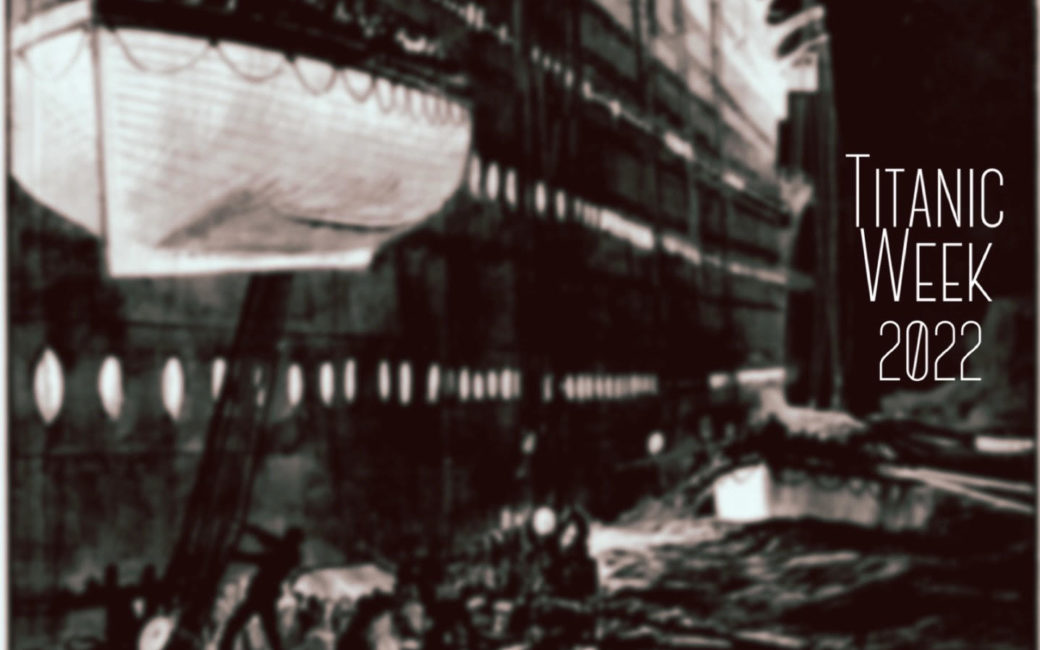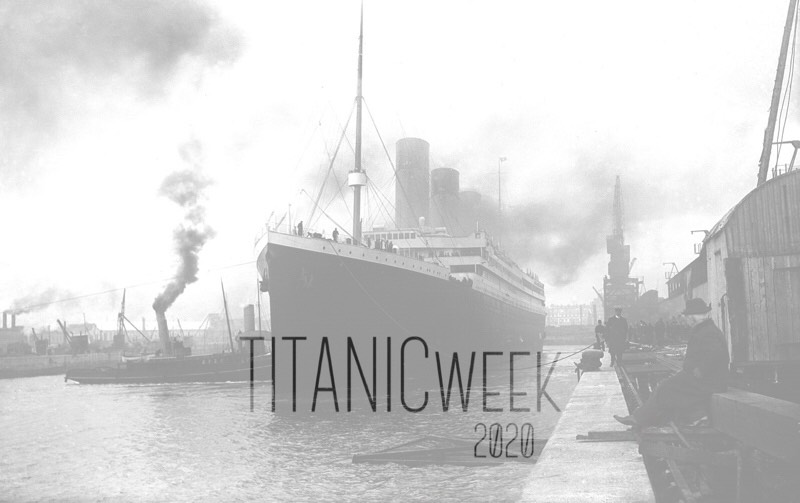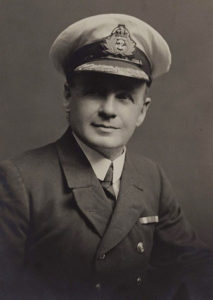"He Kept Bravely On, With Nothing to Guide Him": David Blair, Titanic's Lost Officer
In the course of his civil and military service to the Crown, David Blair was awarded a King’s Gallantry Medal, a British Empire Medal, a Royal Navy Reserve Decoration, the French Cross of Chevalier of the Legion of Honor, and the Officer of the Order of the British Empire Award, bestowed upon him by King George V and signed by Prince Edward.
And yet, David Blair is only remembered as That Guy Who Took That Important Key.
That Guy Who Forgot the Binoculars.
The Man Who Sank Titanic.
And that, dear reader, is horse excrement.
David Blair had originally been assigned as Second Officer on Titanic, and until April 4, that was the circumstance under which the crew operated. This arrangement was in place from the start, and was in operation during Titanic’s sea trials on April 2, 1912.

RMS Titanic docked in Belfast. It is believed that one of the figures standing on the bow is then-Second Officer David Blair.
PUBLIC DOMAIN (Copyright expiration, re: in excess of 70 years after author's death)
The assignments of Titanic’s top officer ranks were as follows:
- William McMaster Murdoch, Chief Officer
- Charles Herbert Lightoller, First Officer
- David Blair, Second Officer
And yet, whether by White Star’s will or at the behest of Captain Smith himself, Henry Wilde was suddenly lined up to take over as Titanic’s Chief Officer. It’s generally understood that the reasoning was because Mr. Wilde was already Chief on Titanic’s elder sister, Olympic. Since it was temporarily berthed, it seemed like Wilde’s experience could be better used on Titanic’s maiden voyage.
Interestingly, Henry Wilde, although aware of the so-called reshuffle as early as March 30, did not receive a proper telegram until April 9, 5 days after Blair’s notice of reassignment.
Charles Lightoller, who was David’s mate, addressed it in his writings, which were published in 1935.
The ruling lights of the White Star Line thought it would be a good plan to send the Chief Officer of the Olympic [Henry Wilde], just for the one voyage, as Chief Officer of the Titanic, to help, with his experience of her sister ship. This doubtful policy threw both [William] Murdoch and me out of our stride; and, apart from the disappointment of having to step back in our rank, caused quite a little confusion Murdoch from Chief, took over my duties as First I stepped back on Blair's toes, as Second, and picked up the many threads of his job, whilst he - luckily for him as it turned out - was left behind.
© "Titanic and Others Ships," by Charles H. Lightoller, 1935. As cited (in part) in "Gilded Lives, Fatal Voyage", by High Brewster, 2012.
So Murdoch and Lightoller were each demoted, and David was pushed off the roster entirely.
He wrote a postcard home to his daughter on April 4, 1912, expressing his disappointment at the decision.
“4th, Southampton
Arrived on 'Titanic' from Belfast today. Am afraid I shall have to step out to make room for [the] Chief Officer of the Olympic who was going in command but so many ships laid up he will have to wait. Hope eventually to get back to this ship...
Been home all day and down on board tonight on watch.
This is a magnificent ship, I feel very disappointed I am not to make the first voyage.”
The word “very” was underlined.
It would seem that David stuck around Southampton to witness Titanic’s departure. It has since been confirmed by facial construction experts and David’s family that the gentleman in black walking along the dock is, in fact, David Blair.
Knowing that, one can’t help but see dejection in his stance.

RMS Titanic docked in Southampton. The man in black walking toward the camera has been identified as Former Second Officer David Blair.
But many people seem to believe that David Blair’s removal from the crew had disastrous consequences. Because when David disembarked, he accidentally took something that should have remained on board.
It was a tiny iron key, with an oval-shaped brass tag that read “Crow’s Nest Telephone Key.”
In the locker opened by that key were David Blair’s looking glasses. And it is speculated that, because the key that David Blair took was of course missing from the ship, that Titanic’s lookouts were without binoculars.
To spot things like icebergs in the distance.
The speculation about the impact of the lost binoculars is not novel—in fact, began in the Senate Inquiry immediately after the disaster. Lookout George Hogg attested to binoculars being on board during Second Officer Blair’s tenure, but that they became unavailable for use before leaving Southampton.
17494. Do you remember when the "Titanic" was leaving Belfast - you signed on the "Titanic" as look-out man, we know - were a pair of glasses given you?
- Yes.
17495. For the crow's-nest?
- Yes.
17496. Who gave them to you, do you remember?
- Mr. Blair, the acting Second Officer then.
…
17501. When you left the ship at Southampton, what did you do with those glasses?
- Mr. Blair was in the crow's-nest and gave me his glasses, and told me to lock them up in his cabin and to return him the keys.
…
17503. As far as you were concerned, the glasses, you were told, were to be locked up in the cabin of the second Officer?
- I locked them up.
17504. And they were locked up. When the ship left Queenstown were there any glasses in the crow's-nest?
- There were none when we left Southampton.
George went on to testify that newly appointed Second Officer Lightoller seemed none too bothered by their absence.
17507. Did you ask for them at all after you left Queenstown?
- After I left Queenstown.
17508. You personally asked for them?
- I personally asked.
17509. Whom did you ask?
- Mr. Lightoller.
17510. Will you tell us what you said to him, quite shortly, about it?
- I said, "Where is our look-out glasses, Sir?" He made some reply, I did not exactly catch it. "Get them later," or something like that.
17511. At any rate, you did not get any?
- I did not get any.
But, despite the sensationalism regarding David Blair’s supposedly fatal moment of forgetfulness, Lightoller’s response to Hogg was neither damning nor surprising. Lightoller would not be troubled by the lack of binoculars because he had his own pair on board with him.
Moreover, the White Star Line was anecdotally the only line of vessels to even provide binoculars to lookouts, as it was unnecessary for spotting endangering objects and was therefore completely against industry practice. And George Hogg’s testimony immediately following, as well as those of his colleagues, attest to as much. Notable captains experienced in disaster, such as Captain Walter Lord of the SS Californian and Ernest Shackleton, were of the same opinion.
17513. Have you had experience of glasses; have you used them much?
- Never before; only in the White Star Line.
17514. But had you used them before you were on this voyage?
- On another ship.
17515. Of the White Star Line?
- In the "Adriatic."
17516. You had never had them in any ship you have been on except in the "Adriatic," which was another ship of the White Star Line you had sailed in?
- No other ship except the White Star.
17517. Did you find them of use?
- Well, I believe in my own eyesight.
…
17522. What it comes to, if I understand that, is you pick it up with your eyesight, and then if you want to see as well as you can what it is you would use the glasses?
- That is what they are handy for, Sir.
17523. But not for picking up things, you mean?
- No, I pick up things with my own eyesight.
And it was understood that George Hogg’s testimony was accurate—binoculars were never intended to spot distant objects. Just to ascertain details.
Additionally, Senator Smith, who conducted the American Inquiry, was in no way familiar with this fact because he was not a mariner in the slightest—a fact that deeply vexed multiple surviving officers who he interrogated, including Second Officer Lightoller and Fifth Officer Harold Lowe.
So, when contemplated within the context of contemporary maritime practice, David Blair’s mistake resulted in nothing more than a perplexity.
Summarily: David Blair did not “doom” Titanic at all.

The RMS Majestic (left) and RMS Olympic, docked in Southampton.
In July of 1912, aboard the RMS Majestic, David was reunited with his friend and Titanic colleague, Charles Lightoller. In a repetition of Titanic’s original assignments, Lightoller was First Officer; Blair, Second.
In 1913, following a stint on the Teutonic during which David had been promoted to First Officer, he returned to the Majestic with his newly acquired superior rank, which he maintained for four months.
But fate was determined to intervene on behalf of The Man Who Doomed Titanic.
On the morning of May 6, 1913, a trimmer (id est, a fireman) chose to attempt suicide by jumping overboard. He was only 27 years old.
David was laying down in his cabin when he heard the cries of alarm. He hastily dressed in his uniform and ran up on deck.
As the fog lifted the officer saw Keoun [the man who jumped ship], apparently very weak, bobbing up and down on the swell, and without a moment's hesitation he dived from the rail of the promenade deck into the water.
David Blair, without a thought as to his own person, swan-dove 40 feet down into 44-degree water, his sight obscured by ocean fog.
According to the New York Tribune's report, the fireman was crazed with heat and recently bereaved. "Keoun lost his wife a month ago, and brooded over her death. Worry, augmented by the heat of the fire room, affected his mind temporarily, and on Tuesday he ran up to the main deck and jumped."
MAJESTIC IN WITH CHIEF OFFICER A HERO
Passengers Cheer David Blair, Who Risked Life in Fog to Save Fireman
---
DIVED IN MIDOCEAN
---
Women Weep as Gallant Sailor and Man for Whom He Jumped Are Helped Over Side
...
Everybody on board except Blair himself, wanted to tell about the rescue yesterday, and Captain Kelk said he felt mighty proud of his chief officer.
...
Mr. Blair, who had been roused from sleep by the cry of "Man overboard!" pulled his trousers over his pajamas and grasping his binoculars rushed forward to a place on the promenade deck just under the bridge. He never took his eyes from the sea until he shouted to the skipper that he saw the helpless fireman.
The passengers said Blair made a perfect dive. When he came to the surface he looked to the bridge, and seeing Kelk pointing in the direction of the fireman, got his bearings and struck out for the man he could not then see.
Once he got a glimpse of the unconscious Keoun as the fireman was tossed up on a wave, and from that tie until he himself was rescued Blair saw nothing but sea and mist.
Thought of Fireman First
He kept bravely on, with nothing to guide him, until the lifeboat came by in search of the fireman. Those in the boat called to Blair to climb in, but he shouted: "I'm all right. Get that fireman first. He should be somewhere about here."
David was celebrated as a hero for this act. But the accolades were short-lived.
On September 8, 1914, on board the RMS Oceanic—and acting as Second Officer alongside First Officer Lightoller once again—David was acting as navigator as the monstrous liner crept in between mainland Scotland the Faroe Islands.
And she ran aground on a reef renowned for its treachery, called the Shaalds of Foula. Fortunately, all souls were saved and the Oceanic was left to her fate.

RMS Oceanic docked in New York, circa 1903. Courtesy of the Library of Congress.
On September 29, a gale turned Oceanic over to the sea. Once visible from shore, local islanders awoke to discover that she had utterly vanished.
David Blair shouldered the blame at the subsequent court martial. Lightoller, however, disagreed entirely with this.
The Oceanic was really far too big for that patrol and in consequence it was not long before she crashed on to one of the many outlying reefs and was lost. The fog was as thick as the proverbial hedge when she ripped up on the rocks; and in all fairness one could not lay the blame on the navigator—my old shipmate of many years, Davy Blair—trying as he was to work that great vessel amongst islands and mostly unknown currents.
© "Titanic and Others Ships," by Charles H. Lightoller, 1935.
But Lightoller had a bit of frivolity planned for them both, while his dear, unlucky friend was in town for the court martial: they were to patrol the coastline disguised as fishermen for the Royal Navy.
Davy Blair, my old Oceanic pal, and I volunteered for a job that we had got wind of in the Flag Lieutenant’s office. The main qualification for the men who were to get it, we were told, was that they should be “Hard Cases.” Well, Davy and I had both done the Western Ocean, and knew it in its worst moods these many years… We were accepted… A visit down sailor town soon completed the outfit, blue jersey, smock, rough serge pants, heavy weather cap, and seaboots, making us the imitation of a perfect fisherman.
© "Titanic and Others Ships," by Charles H. Lightoller, 1935.
David Blair’s subsequent Naval service during the First World War garnered him a number of the afore-stated accolades from the British and French governments. In 1918, he was promoted by the Crown to Lietenant Commander.
In 1923, David was employed as the Commanding Officer on the schooner St. George, leading an immense scientific expedition on a Pacific tour, including the Isthmus of Panama and many of the islands, including the Galapagos.

The steam yacht St. George, docked in Sydney Harbor, Australia, circa 1982. Courtesy of the Australian national Maritime Museum, from the William Hall Collection.
David Blair passed away at 80 years old on January 10, 1955.
Do note that, despite occasional false reports, that David Blair was NOT killed in action in 1917 in a U-Boat encounter during the First World War. This is nothing but irresponsible and lazy reporting. The lost soldier in question was David Blair Chalmers, an Assistant Steward in the Mercantile Marines, aged 26, from Glasgow, Scotland.
In 2007, the infamous key to the crow’s nest sold at auction for £90,000.
SOURCE MATERIAL
"Titanic and Other Ships." Charles H. Lightoller. 1935.









